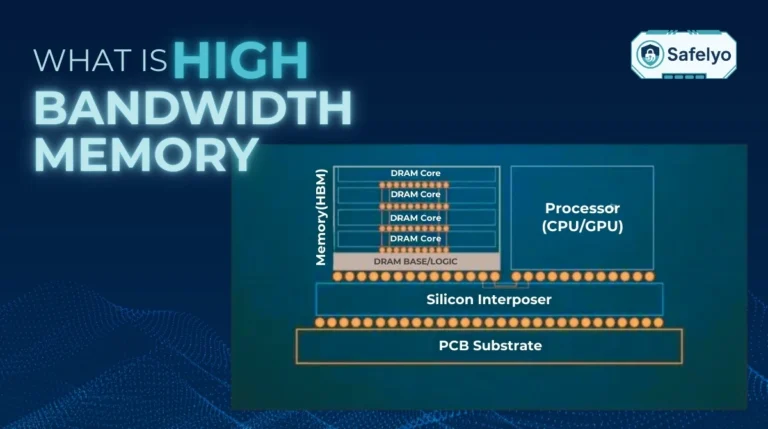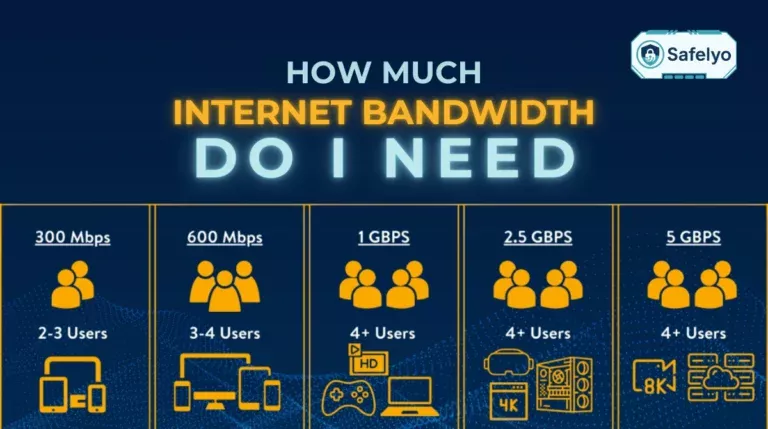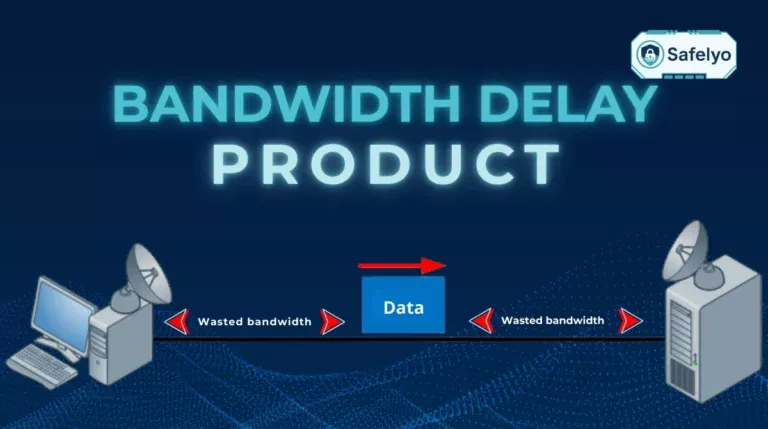You pay your internet provider for a certain ‘speed,’ you run a ‘speed test,’ and you hear gamers talking about ‘bandwidth.’ Think of bandwidth as the number of lanes on a highway – it’s the maximum capacity, not the actual speed of the cars.
In today’s digital world, we rely on our connection for many activities. This includes everything from 4K streaming to important video calls. Understanding what you’re actually paying for is essential. A slow connection can be a major source of frustration, but the cause isn’t always what you think.
With over a decade of experience analyzing network performance, I’ve seen countless people get frustrated with their internet provider. They pay for a 200 Mbps plan but can’t understand why their game is still lagging. The reason is almost always a misunderstanding of the fundamental difference between bandwidth (capacity) and latency (delay).
In this comprehensive guide, you’ll discover:
- The crucial difference between bandwidth, speed, throughput, and latency.
- How is bandwidth measured, and what do the numbers really mean?
- How much bandwidth do you actually need for activities like streaming?
- Simple tips to check and improve your network’s performance.
Don’t let confusing terms keep you in the dark about your own internet connection. Let me be your guide to understanding what is bandwidth in networking.
1. Bandwidth vs. speed vs. throughput vs. latency
The world of networking is filled with terms that sound similar but mean very different things. As an analyst, the biggest source of confusion I see is the mix-up between bandwidth, speed, and latency. The clearest way I’ve ever found to explain it is to stop thinking about data and start thinking about traffic on a highway.
Bandwidth (The Number of Lanes)
First, what is bandwidth? Think of it as the number of lanes on a highway.
- A massive 10-lane superhighway has a very high bandwidth. It has the capacity to handle a huge number of cars (data) at the same time.
- A 2-lane country road has a low bandwidth. Its maximum capacity is much smaller.
Bandwidth is the maximum potential of your connection. It’s the number your Internet Service Provider (ISP) sells you (e.g., 100 Mbps).
Throughput (The Actual Traffic Flow)
This is where the confusion arises. The distinction between bandwidth and throughput represents the gap between theory and reality.
- Throughput is the number of cars actually getting through the highway right now.
- A 10-lane highway (high bandwidth) might have very low throughput if there’s a traffic jam (network congestion) or a crash ahead.
- Conversely, a 2-lane road (low bandwidth) could have high throughput if it’s completely empty and traffic is flowing smoothly.
Throughput is your actual, real-world performance at any given moment.
Speed (The Speed Limit)
So, what about the difference between bandwidth and speed?
- Speed is how fast the cars are allowed to travel on that highway. It’s the speed limit.
- Your ISP might sell you a “100 Mbps speed” plan, but that’s really just another way of saying “100 Mbps bandwidth.” However, your actual travel time depends on the throughput. A fast speed limit on a congested, gridlocked highway is completely useless.
Latency (The Travel Time)
This is the final, and often most important, piece of the puzzle. The difference between bandwidth and latency is critical, especially for gamers.
- Latency (or “ping”) is the time it takes for one single car to travel from Point A to Point B.
- Having a wider highway (more bandwidth) does not make a single car travel any faster. A single car goes the same speed on a 2-lane road as it does on a 10-lane highway if both are empty.
- Latency is determined by physical distance and the number of intersections (network hops) along the way. Low latency is crucial for real-time applications where “reaction time” matters most.
2. Deconstructing the highway: A closer look at each concept
The highway analogy is the key, so let’s park the car for a moment and examine each piece individually. I find that breaking down these four concepts is the best way to diagnose your own internet problems. Is your “road” too narrow, or is it just a long, winding path?
2.1. Bandwidth
Bandwidth is the maximum capacity of your connection. In our analogy, it’s the number of lanes on your highway.
- A connection with high bandwidth (e.g., 500 Mbps) is like a 10-lane superhighway. It is capable of handling a massive volume of traffic (many cars) simultaneously.
- A connection with low bandwidth (e.g., 10 Mbps) is like a 2-lane country road. Its maximum potential is much lower.
This is the number your ISP sells you. It’s the theoretical maximum, not what you get every second of every day.
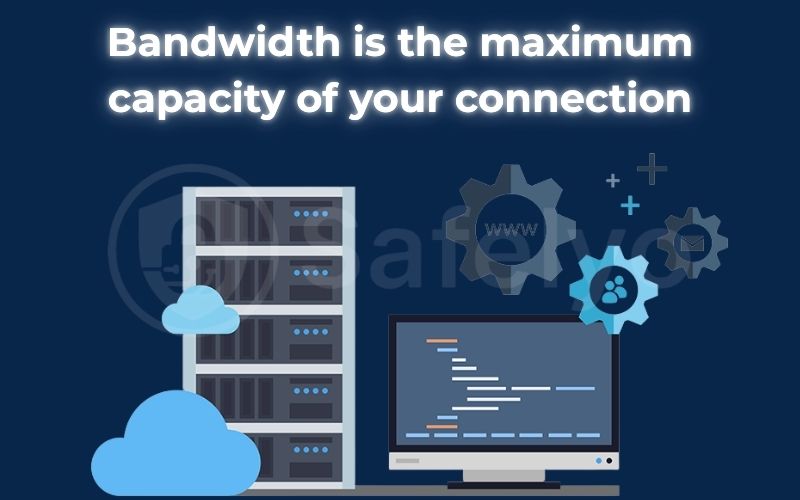
2.2. Throughput
Throughput is the actual amount of data successfully moving through your connection right now. It’s the real-time flow of cars on the highway.
- Even a 10-lane superhighway (high bandwidth) will have terrible throughput if it’s rush hour and there’s a traffic jam (network congestion).
- Your throughput can be limited by many factors: Your Wi-Fi signal, your router’s age, server overload at the destination, or your ISP slowing you down (bandwidth throttling). This is why your “speed test” result is almost always lower than the bandwidth you pay for.

2.3. Speed
Speed is the most confusing term because it’s often used interchangeably with bandwidth.
- Think of the “speed” your ISP sells you as the speed limit of the highway.
- While a high speed limit is great, it’s the throughput that determines how long your journey takes. A 100 mph speed limit is useless in a gridlock. When you run an online “speed test,” what you are actually measuring is your throughput at that exact moment.

2.4. Latency
Latency (also called “ping”) is the time it takes for a single piece of data to make a round trip from your computer to a server and back again. It’s the total travel time for one car.
- A wider highway (more bandwidth) does not make a single car’s journey faster. The travel time is determined by physical distance and the number of intersections (network hops).
- Low latency (a short travel time) is critical for real-time applications like online gaming and video calls, where your connection’s “reaction time” is what matters most.
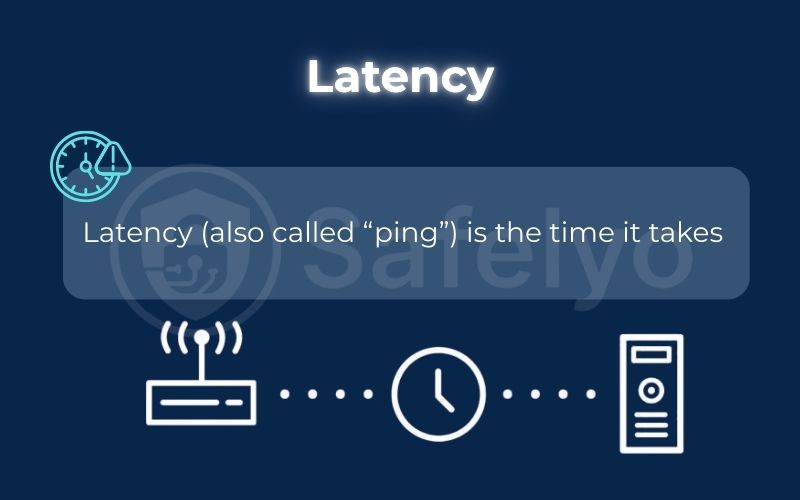
3. How is bandwidth measured, and what do the numbers mean?
Now that we understand the concept, let’s talk about the numbers you see in your internet plan or on a speed test result. How is bandwidth measured? It’s measured in bits per second (bps), which represents the amount of data that can be transferred in one second.
In my daily work, I almost exclusively deal with two main units:
- Mbps (Megabits per second): This is the standard for most home internet connections. One megabit is equal to one million bits. A 100 Mbps connection can theoretically transfer 100 million bits of data every second.
- Gbps (Gigabits per second): This is common for high-speed fiber connections and the internal networking of data centers and VPN servers. One gigabit is equal to one billion bits, or 1,000 Mbps.
It’s also crucial to understand the direction of your bandwidth, which is often not the same.
Symmetrical vs. Asymmetrical Bandwidth
To make the difference even clearer, here’s a side-by-side comparison:
| Feature | Asymmetrical Bandwidth | Symmetrical Bandwidth |
| Download vs. Upload | Download speed is much faster than upload speed. | Download and upload speeds are the same. |
| Common Technology | Cable, DSL, most non-fiber connections. | Fiber Optic connections. |
| Best For… | Consuming content: Streaming, browsing, downloading files. | Creating & Interacting: Video calls, uploading large files, live streaming. |
| Highway Analogy | A highway with 8 lanes coming in, but only 2 lanes going out. | A highway with 8 lanes in both directions. |
Asymmetrical Bandwidth (Most Common)
This is what the vast majority of cable and DSL internet plans provide. Your download speed is much faster than your upload speed. You might see a plan advertised as “100 / 10 Mbps.” This means you get 100 Mbps for downloading data. This is useful for activities like streaming a movie. However, you only get 10 Mbps for uploading data. This affects tasks like sending a large email attachment or being on a video call. For most consumption-based activities, this is perfectly fine.
Symmetrical Bandwidth
This is a key feature of most fiber optic internet plans. Your download and upload speeds are the same (e.g., 100 Mbps / 100 Mbps). From my personal experience, having a symmetrical connection is a game-changer. It’s ideal for anyone who regularly participates in video calls, uploads large files to the cloud (like videos or photo libraries), or live streams content. The high upload capacity makes these tasks significantly faster and more reliable.
4. Why is bandwidth important for your digital life?
So, why does all this matter? Why is bandwidth important beyond just a number on your internet bill? Because in our highway analogy, a wider road allows for more complex and simultaneous traffic without causing a jam. Your bandwidth determines how many high-demand digital activities your network can handle at once.
4.1. For Streaming, Gaming, and Browsing
This is the most common use case. Having high bandwidth is what allows a modern household to function smoothly. It means you can stream a 4K video in the living room. Meanwhile, someone else can be in an intense online game in their bedroom. Another person can be on a work video call in the home office. All of this happens without buffering, lag, or dropped connections.
Low bandwidth, on the other hand, is like trying to merge three lanes of rush-hour traffic onto a single-lane country road. It creates a bottleneck, and everyone’s experience suffers.
4.2. For your VPN connection
When I test VPNs, one of the first things I look at is the provider’s server infrastructure. Here’s why bandwidth is critical for your VPN connection:
- Minimizing Speed Loss: The process of encrypting your traffic adds a small overhead, which can slightly reduce your connection’s throughput. If you start with a high-bandwidth connection (e.g., 200 Mbps), this small percentage reduction is completely unnoticeable.
- “Unlimited Bandwidth”: When a VPN provider advertises “unlimited bandwidth,” it means two things. First, they won’t cap the amount of data you can use. Second, and more importantly, they’ve built their server network with extremely high-capacity connections (often 10 Gbps servers). This ensures that their “highway” is always much, much wider than yours, preventing their servers from becoming the bottleneck in your connection.
4.3. For your VPS hosting
If you run a website or an application on a Virtual Private Server (VPS), bandwidth is a critical resource you pay for. In this context, it represents the “width” of the connection from your server to the internet.
Every time a visitor loads your website, they are using a small piece of your server’s bandwidth. If your site suddenly gets a huge surge of traffic (for example, from a viral social media post), you can exceed your monthly bandwidth limit. When this happens, your hosting provider may either charge you overage fees or, in some cases, temporarily slow down or take your site offline until the next billing cycle. This is why choosing a hosting plan with enough bandwidth is crucial for growing websites.

5. How much bandwidth do you actually need?
This is the million-dollar question. Internet providers love to sell ever-larger numbers – 500 Mbps, 1 Gbps, 2 Gbps – but how much bandwidth do you actually need? The answer is often far less than you think.
The bandwidth requirements for streaming and other common activities are surprisingly modest. Here are some general guidelines I use when advising people, based on data from major streaming services and my own testing. These numbers are per user or device.
| Activity | Recommended Minimum Bandwidth |
| Basic Browsing & Email | 1-5 Mbps |
| HD Video Streaming (1080p) | 5-8 Mbps per stream |
| 4K Video Streaming (UHD) | 25 Mbps per stream |
| Online Gaming | 3-6 Mbps |
| Video Conferencing (HD) | 2-4 Mbps per user |
The Family Rule: It’s All About Concurrency
The real key isn’t the requirement for a single activity, but how many activities are happening at once. This is where your total bandwidth capacity becomes important.
Here’s a practical example. A family of four might have a 4K TV streaming Netflix, which requires 25 Mbps. One person could be playing a game on a PlayStation 5, using around 5 Mbps. Another person might be on a FaceTime call, which needs 4 Mbps. Lastly, someone could be casually browsing Instagram, using about 3 Mbps.
Total Concurrent Need: 25 + 5 + 4 + 3 = 37 Mbps
In this very common scenario, a basic 50 Mbps internet plan would provide a smooth experience for everyone. A plan of 100-300 Mbps offers a comfortable buffer for background downloads and additional devices. Anything beyond that, for most households, is often overkill unless you are frequently downloading massive files (like new video games, which can be over 100 GB). Don’t pay for a 10-lane highway if your family’s rush hour only ever fills three or four lanes.
6. How to manage and increase your bandwidth
If you’ve determined that your internet experience is sluggish and you suspect a bandwidth issue, there are several steps you can take. Before you call your ISP to upgrade, it’s a good idea to play detective on your own network.
6.1. What is using my bandwidth?
The first question I always ask is, “Do you know where your bandwidth is going?” Often, a single device or application is the culprit.
- Finding the Culprit: You can often check your router’s administration panel for a list of connected devices and their current data usage. For a more detailed view on a Windows PC, I highly recommend a tool like GlassWire. It gives you a beautiful, real-time graph showing exactly which applications are the biggest bandwidth hogs.
- The Usual Suspects: Nine times out of ten, the culprits are predictable: 4K video streaming services (Netflix, YouTube TV), large game downloads or updates (Steam, Xbox), and cloud backup services (iCloud, Google Drive, Backblaze) running in the background.
6.2. How to increase bandwidth and performance
Once you know where your data is going, you can take steps to improve your overall network performance.
- Upgrade Your Internet Plan: This is the most direct way to increase bandwidth. If your family’s needs consistently exceed what your plan offers, calling your ISP and paying for a wider “highway” is the only real solution.
- Upgrade Your Router: This is the most underrated tip. I’ve seen countless people pay for a 500 Mbps plan but use a five-year-old router that can barely deliver 100 Mbps over Wi-Fi. An old or cheap router can be a major bottleneck. Upgrading to a modern Wi-Fi 6 or Wi-Fi 6E router can make a massive difference.
- Use a Wired Ethernet Connection: A wired connection is always faster and more stable than Wi-Fi. For stationary, high-demand devices like a gaming PC, a PlayStation, or a smart TV, I always recommend plugging in an Ethernet cable directly to the router if possible. This guarantees the best possible throughput.
- Reduce Network Congestion: This is about managing usage. If you need to be on an important video call, it may not be the best time for someone else in the house. Starting to download a 150 GB video game could cause issues. Coordinate high-bandwidth tasks to avoid creating your own digital traffic jam.
- Use Quality of Service (QoS): Many modern routers have a QoS feature. This allows you to tell your router which type of traffic is most important. You can prioritize traffic for specific applications (like your work video conferencing app) or specific devices (like your Xbox), ensuring they get the “fast lane” when the network is busy.
7. FAQ about the bandwidth in networking
We’ve covered the highway analogy and the practical tips for managing your connection. Here are some quick, direct answers to the most common questions people have about network bandwidth.
What is bandwidth in networking?
What is bandwidth in networking? It is the maximum theoretical capacity of a network connection to transfer data in a given amount of time. Think of it as the number of lanes on a highway – it determines how much data (traffic) your connection can handle at once. It is typically measured in Mbps or Gbps.
What is bandwidth vs internet speed?
This is the most common point of confusion. Bandwidth is the capacity of your connection (the width of the highway). What people call “internet speed” is actually throughput – the actual rate at which data is successfully transferred at a given moment (the speed of the cars in current traffic). Your throughput can be lower than your bandwidth due to factors like network congestion.
What does a high bandwidth mean?
A high bandwidth (e.g., 500 Mbps or 1 Gbps) means your network connection has a very high capacity. It can handle many demanding online activities – like multiple 4K video streams, online gaming, and large file downloads – simultaneously without slowing down. It’s like having a very wide, multi-lane highway.
How do I know my internet bandwidth?
To find your official bandwidth, you need to check your internet service plan from your ISP. To measure your current throughput (what most people think of as speed), you can use a free online tool like Speedtest by Ookla or Fast.com. This will show you your current download and upload performance.
Does unlimited bandwidth really mean unlimited?
Not always. “Unlimited bandwidth” from an ISP usually means there is no hard data cap on your monthly usage. However, many providers have a “fair use” policy and may still engage in bandwidth throttling (intentionally slowing you down) during peak hours if you are an extremely heavy user.
Will a VPN increase my bandwidth?
No, a VPN cannot increase the maximum bandwidth provided by your ISP. The encryption process will always add a small overhead that slightly decreases your speed. However, a VPN can sometimes improve your throughput by bypassing bandwidth throttling from your ISP, as they cannot see the type of traffic you are using.
8. Conclusion
Understanding what is bandwidth in networking is as simple as understanding the difference between the number of lanes on a highway and the speed of the cars driving on it. It’s a measure of capacity, not a guarantee of performance, and it works together with latency and throughput to create your total online experience.
- Bandwidth is capacity, not speed. It’s the maximum amount of data your connection can handle.
- Throughput is your actual, real-time performance, which can be affected by congestion.
- Latency is delay, and it’s just as important as bandwidth for real-time applications like gaming.
- Know your needs: Match your internet plan’s bandwidth to your household’s streaming and browsing habits.
By understanding these core concepts, you can become a smarter consumer, a better troubleshooter, and a more empowered internet user, ensuring you’re getting the performance you’re paying for.
A high-bandwidth connection is great, but it’s not private. Learn how to protect that connection by exploring the reviews of the best VPNs that offer unlimited bandwidth and top-tier security in the Privacy & Security Basics section of Safelyo.


